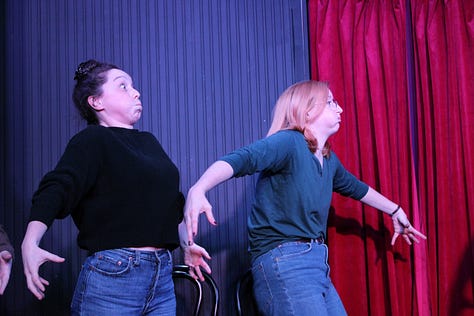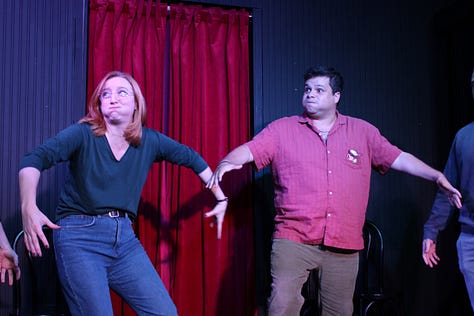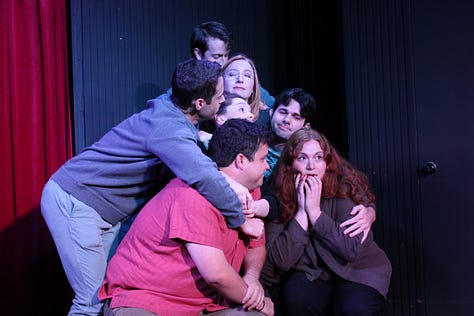Sound and Movement
improv's answer to clowning?



The long form improv bubble in America burst right before Covid. Although improv is not going away, it feels less relevant and cool than, say, clowning or solo character work.
Will improv ever again become the “hot” thing in comedy, like it was after 1990s Chicago folk (Tina Fey, Amy Poehler, Adam McKay, the UCB Theatre) brought it to the mainstream?
If it does, I bet it will happen because of sound and movement.
When I say sound and movement, I mean when an improv team goes non-verbal and does abstract physicality and sounds, usually all copying each other. It’s downstream of “Follow the Follower” or “Mirror” exercises. Everyone jumps around like monkeys, or hunches forward making fish faces, or slowly creeps around pretending to workshop an invisible statue, etc.
You know what I mean: it looks insane.
Small Business
A team at my theater called Small Business recently started doing sound-and-movement as an opening for their shows. It’s been funny and refreshing and new.
They get a suggestion, turn to face each other and start doing some physicality. They speak in gibberish or with very short phrases. After a few moments, they allow their performance to solidify into a scenic moment. So they’ll be heaving their arms into the air, and then resolve into a group of picketers, or folks throwing frisbees. Then soon everything melts back into an abstract soup.
We called that “rooms and hallways” when I was a student. Chaos, order, chaos.
Then after five (!) or so minutes, the group starts doing scenes, using the snapshots from their opening as starting points. I believe they use sound-and-movement to transition between scenes sometimes also.
Their sets have felt dreamlike and permanently surreal. It’s like a David Lynch movie. Even when it’s four people sitting in an office, there’s this feeling that a demon could enter at any moment, or that one of them could suddenly devour the other.
It’s very funny. The audience sits and smiles throughout. It creates an energy that has been missing.
Clowning Energy
Part of this is the nature of that group. We assembled Small Business by taking experienced improvisers who were both good actors (committed, invested) and who took big swings in their shows — huge choices, fast decisions, left turns — and put them together. I don’t think a new or shy group could pull this off.
But in this group’s hands, the sound and movement sections are extremely fun. The group is smart and fast enough to “land” the chaos into simple scene moments. They seem to enjoy the insanity both earnestly and also giggling a bit at how foolish it all seems.
It feels like aspects of clowning shows I’ve seen. While I’ve never studied clowning — and “clowning” is a term that can apply to many particular schools of theater — I’ve seen a good handful of shows in LA that call themselves clown. They’re often abstract, nonverbal, and involve a lot of physicality and in-the-moment adjustments.
There’s a rock show/party element to a good clown show that’s been missing from improv. But I’ve felt it again during a sound-and-movement sets.
Why It Went Away
In UCB and UCB-adjacent theaters, sound and movement is not done a lot. It’s a chore you sometimes do in class as an exercise. If it’s done in a show, it’s usually a joke.
The UCB Theatre as a movement has generally been about making improv LESS abstract. It’s been more about getting to the comedy faster, and about bringing top-of-your-emotional-intelligence thinking into play.
The biggest hit UCB shows have been very accessible. They start with monologues, “living room” style discussions, or audience interviews. You speak with people as real people, then start scenes with comedy premises RIGHT AWAY.
It’s been a powerful revolution. Improv that looks as smart and real as a conversation. This style of improv fought back against the silliness of short-form, against the perception that improv was basically just kids games — and made it “real” comedy.
Sound-and-movement feels too much like the uncommitted undefined silliness that UCB was fighting against to fit in there.
But the literal shows feel stale. Improvisers use monologue openings to sit down, fold their arms and detach. They chat forever, delay doing scenes and then smirk their way through the set.
I’m pointing at myself the most of all when I say this.
The commitment is gone. The danger is gone.
Sound and Movement at UCB
There have been exceptions at UCB where teams have done sound-and-movement. My first house team at UCB (in 2001) was coached by Billy Merritt, and on his suggestions we did sound-and-movement openings and transitions. We had fun and could sometimes pull it off, but in my memory we were all new players who struggled to consistently deliver. Although I do remember several of the top performers rcomplimenting us after these sets and asking “how” we did it.
A bit later, the team Optimist International started doing sound-and-movement. This was a heavy-hitter team with Jack McBrayer, Brian Huskey, Shannon O’Neill and Chris Gethard. They crushed with it.
Then a few years later, Gethard coached the team fwand (Jon Gabrus, Ellie Kemper, Shannon, Gil Ozeri, Chelsea Clarke, Kevin Hines) and THEY did sound-and-movement. It became their trademark.
It was a good fit for teams with funny people who were stymied by cerebral things like pulling premises or strict second beats. The sound-and-movement (we called it “organic” for a while) opened them up.
In LA, there hasn’t been too much of this at UCB. Although the team Cardinal Redbird (coached by Billy and me) did do it for a year!
I understand why it hasn’t been more embraced. Sound-and-movement is a nightmare if it’s not done with full commitment. Or if the team lacks the decision power to quickly solidify the chaos into something scenic.
But when done properly, it brings danger and playfulness and is very very funny.
Even if you dislike sound-and-movement in performance, I heartily recommend doing it as an exercise in class. It gets you out of your head. It makes your instincts louder. It unlocks the performers’ voice and style.
And maybe, in the right show, can revitalize the entire medium.
Q&A Coming
I’m doing a Q&A for paid subscribers soon! If you’re a paid subscriber and want a questions answered, reply to this email and send it to me soon, like by end of the day Monday! I have some great ones but can always use more.
Plugs
The World’s Greatest Improv School: The improv school I run with Jim Woods and Sarah Claspell. We’ve got classes online, in LA and even a few in NYC! You can join our mailing list if you want our weekly announcement of shows.
How to Be The Greatest Improviser On Earth - My improv book, available at Amazon. Kindle or print (also on my web site for more if you don’t want to buy from Amazon). It’s a hodge-podge of advice I wrote in 2016 about doing improv. If you’re short of funds and want a free PDF version just email me and I’ll send it over.
Subscribe!
Paid subscribers to this Substack get their own Q&A columns where they can ask questions. Start a paid subscription to get access to these Q&As.
Everything else is free for everyone. Thank you for reading!

